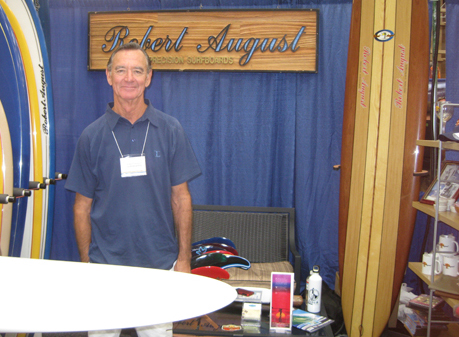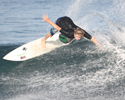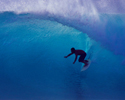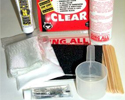Shaper Interviews
Robert August: Finding The Perfect Surfboard

Robert August gained international fame at a young age when he starred in Bruce Brown’s 1964 classic surf movie “Endless Summer”. The movie would eventually define a genre and show the surf world the adventure and potential of true surf travel. He began shaping in 1966 and eventually opened his own shop in 1974. August enjoyed the longboard revival of the 1990s after feeling that his shop full of shortboards was missing something important to surfing.
SurfScience spoke with the legendary shaper about the past, present and future of surfing.
SurfScience: Tell us what being a surfboard shaper means to you.
Robert August: If you’re a surfer and you’re involved with the sport then you always want to know what it would be like to shape a board and ride it. In the industry the creative part of making a surfboard is the shape. That’s what makes it go a certain way through the water and turn and gain speed. You can teach someone to glass a board and shape a board. But the shaping thing…you have to shape a variety of boards if you’re a real shaper. It’s not repetitious, you’re making different stuff all the time.
Being a designer as I am there are a few factors in surfboards that are consistent. When you’re surfing you want to be able to do two things: You want some speed but you also want to be maneuverable. There’s times you’ve got to cut back. And there’s times when you have to speed up to make the section. And you also want to paddle reasonable well. You want to catch the wave. All those things have to do with the shape of the board, which is the thickness, the width, and the rocker.
The rocker in the board is the important part. You make a flat board it goes really fast, it just does. But it’s really difficult to cut back and turn; it’s stiff. You make a board with super rocker, like the high performance boards, they’re really slow because they push a lot of water, but they turn real easy. As a shaper you’re always dealing with those factors.
The board that I ride is somewhere in between. You do want to paddle well and if you’re taking off on the right spot you want it to be challenging to try to make the wave. That’s where you gonna get the most speed. You want to go fast but you also want to cut back and get in the next little section. That makes it so interesting. The two design factors are the two things you want to do when you’re surfing.
You also want to take into consideration the surfer’s experience and his weight. If you have a big fat guy, then you need to deal with that. You want to make sure he floats, he’s stable, and he can catch the wave. Also, you want to find out the tolerance level where he can still turn this thing. That’s fine he caught a wave, but sooner or later he will want to turn and ride the wave.
To be a shaper is very interesting. Some guys shape the same things over and over, but I sure don’t. I make a variety of stuff from 5 foot to 12 foot. The job of a shaper is to be able to do what the customer wants. It’s my job to listen and to be able to do what he wants to make him the happiest guy in California. If I do that and he’s totally stoked, he gets the board when it’s glassed and ready, he’s the happiest guy you’ll ever see.
You know as a surfer there’s nothing cooler than getting a new board. The first time you wax it up. The first time you jump on it and paddle it. Each one has its own personality. If that board is exactly what you had in mind there’s nothing better. It’s so cool.
SS: Is finding the balance between these different aspects what made you successful?
RA: In my own boards that I ride there is a combo between speed, maneuverability, and flotation that I think makes it a really good board. If you only have one board you want to be reasonable and get some waves. So if it is 8 foot and hollow you go “I can deal with that. It’s not impossible on this board”. Or, if it’s mushy and high tide, you can go “I can still cruise and get on the nose of this thing”.
SS: What do you think about progression? Some people think surfboard design is slow to progress. What are you doing to progress design?
RA: A lot of the progression comes from surfers themselves. The surfers get better and better and you try to keep up with their skill. They’re so much better than they were 25 years ago. A lot of it is a combination of these surfers getting so good and then matching up with a new design. These guys are so good that if it doesn’t turn as well they can deal with it. They just overpower the thing and they’re getting more speed. A lot of it is just keeping up with how good these guys are. And then as a shaper I’ll look at something and say “that’s a good design. I’m sure it would work better if I did something to that”.
If you’re gonna make a change or an improvement, then you want to make sure it’s something positive. If he’s knowledgeable enough then he’ll say “that’s great. That’s much better than the board I have”. Then you’ve improved his surfing. It’s the responsibility of being a shaper. I see guys who say “I don’t shape those. You ride what I shape. That‘s the best board”. I don’t know if that’s really my job as a shaper. Everybody surfs a little different. Personal preference makes it interesting.
SS: What advice would you give for people looking for the right surfboard?
RA: The cool thing now is there is so much variety out there. Before you would just imagine in your mind what would be good and then go buy one. I say try one. Try five of your friends’ boards. Narrow it down. You can also think that in the future you really need to improve on your backside bottom turn, for example, and get a board and work on that. Put that in your mind when getting your next board. Try a few boards and decide which direction you want to go.
SS: What are some common misconceptions you hear?
RA: Sometimes I look at a board and think “Artistically that might be interesting, but I don’t know anyone who would want to ride that thing”. That’s the creative part of it. There are no rules. No correct way to make a board. There’s quality in shaping. There is professionalism, but I can’t say my boards are better than Bill Stewart’s because his are different than mine.
There are some designs that I think are unnecessary or not very functional. They don’t really add to the way the board rides. You know how tails on boards now are square? The rails are regular and then square. It looks like they didn’t finish it off. They’re thinking that is going to make a really sharp edge back there on the tail. The sander puts an edge on it anyway. After you glass the top and bottom with a hot coat it’s round. The squareness and the rails being an inch think and square I don’t get. It looks lazy to me.
Surfing has no rules. You get out there and screw around. The guy having the most fun is the winner. He could be a very average surfer, but when he gets out of the water he’s ecstatic. It’s the best day of his life. You might not think he’s not very good, but for his skill level and experience he’s great. That’s the great part about surfing. That’s his style; he can do that if he wants.
What does the future hold for Robert August surfboards?
RA: We make such a variety of stuff. My goal is to make as many people as happy as possible. I don’t have my mind a different shape or construction process that will change the world of surfing. I don’t know where it will go. Surfers are so darn good right now. You always think no one will ever be better, but it happens. Four years from now there will be someone who will make you say “Holy Cow, how did he do that?”. It’s an exciting time.















0 Comments